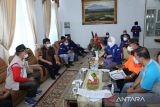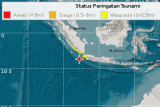Kathmandu, May 1 (ANTARA Lampung/Reuters) - Nepali and foreign officials were struggling on Friday to locate thousands of people still missing after last week's massive earthquake, as food and other relief supplies began to trickle through to those stranded in remote parts of the country.
Up to 1,000 Europeans are among the missing, mostly around popular trekking routes, the head of the European Union (EU) delegation in Nepal said.
"We don't know where they are, or they could be," Ambassador Rensje Teerink told reporters. Officials said it was hard to trace the missing because many backpackers do not register with their embassies in the country.
However Nepal's home ministry said it had not been informed the number of EU citizens missing could be that high.
"If that is the case then why are the embassies not informing us? Why have they not contacted the Nepal
government?," home ministry spokesman Laxmi Prasad Dhakal told Reuters.
The number of people missing from France, Italy and Spain is 221 according to checks Reuters made with their governments, while other European nations are yet to provide an updated figure on how many of their citizens are unaccounted for.
The confirmed death toll from last Saturday's disaster has risen to 6,250, with 14,357 injured according to the government.
There is no number for the missing, but bodies are still being pulled from the debris of ruined buildings, while rescue workers have not been able to reach some remote areas.
In the capital Kathmandu, many unclaimed bodies were being quickly cremated because of pressure on mortuaries. Besides the possibility of disease, the stench of the corpses was spreading through localities where buildings had collapsed.
Many bodies could be migrant workers from neighbouring India, who would be living alone in the Himalayan nation, local officials said.
"Morgues are full beyond capacity and we have been given instruction to incinerate bodies immediately after they are pulled out," said Raman Lal, an Indian paramilitary force official working in coordination with Nepali forces.
Aid was beginning to slowly reach remote towns and villages nestled in the mountains and foothills of the impoverished nation. But government officials said efforts to step up the pace of delivery were frustrated by a shortage of supply trucks and drivers, many of whom had returned to their villages to help their families.
"Our granaries are full and we have ample food stock, but we are not being able to transport supplies at a faster pace," said Shrimani Raj Khanal, a manager at the Nepal Food Corp.
Army helicopters have air-dropped instant noodles and biscuits to remote communities but people need rice and other ingredients to cook a proper meal, he said.
Many Nepalis have been sleeping in the open since the 7.8 magnitude quake, with survivors afraid of returning to their homes because of a series of powerful aftershocks. According to the United Nations (UN), 600,000 houses have been destroyed or damaged.
Information Minister Minendra Rijal said the government would provide $1,000 in immediate assistance to the families of those killed, as well as $400 for cremation or burial.
The UN said 8 million people in the country of 28 million were affected, with at least 2 million needing tents, water, food and medicines over the next three months.
Finance Minister Ram Sharan Mahat said Nepal would need at least $2 billion to rebuild homes, hospitals, government offices and historic buildings and appealed for help from international donors.
"This is just an initial estimate and it will take time to assess the extent of damage and calculate the cost of
rebuilding," Mahat told Reuters.
Prime Minister Sushil Koirala told Reuters earlier this week the death toll from the quake could reach 10,000.
That would surpass the 8,500 who died in a 1934 earthquake, the last disaster on this scale to hit the Himalayan nation sandwiched between India and China.
Home ministry spokesman Dhakal said that though the 1934 quake was more powerful, there were fewer people in the Kathmandu valley then.
"The scale of reconstruction will be unprecedented," Dhakal said.
Anger over the pace of the rescue has flared in some areas, with Nepalis accusing the government of being too slow to distribute international aid that has flooded into the country.
"There have been cases where villages have pelted stones on trucks carrying aid and food supplies. They must have been really hungry and angry to do so," said Purna Shanker, who works at the government's commodity trading office.
In Sundarkhula, a village close to the quake's epicentre west of Kathmandu, villagers said they were searching their destroyed homes for food.
Bharat Regmi, 28, said he jumped out of the first floor as the quake lifted his house from its foundations. When he went back a few days later, he and two of his friends found a bag of potatoes in the rubble.
"We are living on water and whatever we can dig out from the house," he said, standing under steady rain near the highway to Kathmandu. Later, he crept back under a thin orange sheet being shared by about a dozen other villagers.
Tensions between foreigners and Nepalis desperate to be evacuated have also surfaced.
In the Himalayas, climbing is set to reopen on Mount Everest next week after damage caused by avalanches is repaired, although many have abandoned their ascents.
An avalanche killed 18 climbers and sherpa mountain guides at the Everest base camp.









